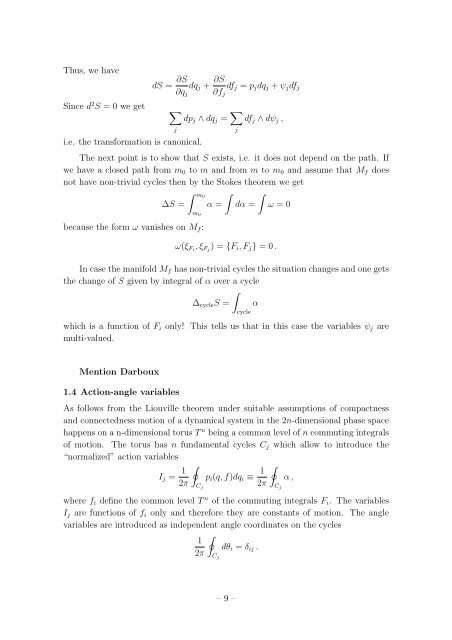Student Seminar: Classical and Quantum Integrable Systems
Student Seminar: Classical and Quantum Integrable Systems
Student Seminar: Classical and Quantum Integrable Systems
You also want an ePaper? Increase the reach of your titles
YUMPU automatically turns print PDFs into web optimized ePapers that Google loves.
Thus, we have<br />
Since d 2 S = 0 we get<br />
i.e. the transformation is canonical.<br />
dS = ∂S<br />
∂q j<br />
dq j + ∂S<br />
∂f j<br />
df j = p j dq j + ψ j df j<br />
∑<br />
dp j ∧ dq j = ∑<br />
j<br />
j<br />
df j ∧ dψ j ,<br />
The next point is to show that S exists, i.e. it does not depend on the path. If<br />
we have a closed path from m 0 to m <strong>and</strong> from m to m 0 <strong>and</strong> assume that M f does<br />
not have non-trivial cycles then by the Stokes theorem we get<br />
∫ m0<br />
∫ ∫<br />
∆S = α = dα = ω = 0<br />
m 0<br />
because the form ω vanishes on M f :<br />
ω(ξ Fi , ξ Fj ) = {F i , F j } = 0 .<br />
In case the manifold M f has non-trivial cycles the situation changes <strong>and</strong> one gets<br />
the change of S given by integral of α over a cycle<br />
∫<br />
∆ cycle S = α<br />
which is a function of F i only! This tells us that in this case the variables ψ j are<br />
multi-valued.<br />
cycle<br />
Mention Darboux<br />
1.4 Action-angle variables<br />
As follows from the Liouville theorem under suitable assumptions of compactness<br />
<strong>and</strong> connectedness motion of a dynamical system in the 2n-dimensional phase space<br />
happens on a n-dimensional torus T n being a common level of n commuting integrals<br />
of motion. The torus has n fundamental cycles C j which allow to introduce the<br />
“normalized” action variables<br />
I j = 1<br />
2π<br />
∮<br />
C j<br />
p i (q, f)dq i ≡ 1<br />
2π<br />
∮<br />
C j<br />
α ,<br />
where f i define the common level T n of the commuting integrals F i . The variables<br />
I j are functions of f i only <strong>and</strong> therefore they are constants of motion. The angle<br />
variables are introduced as independent angle coordinates on the cycles<br />
1<br />
2π<br />
∮<br />
C j<br />
dθ i = δ ij .<br />
– 9 –

















